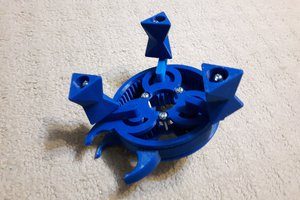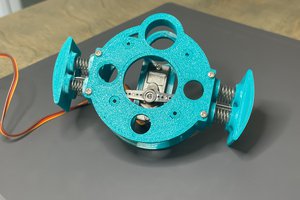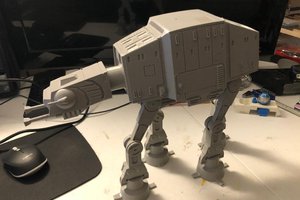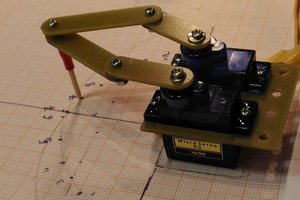STL and Fusion 360 source files can be found here: https://bbprojects.technology/collections/stl-fusion-360-source-files/products/robot-hand-bionic-hand-prosthesis-prototype
video:
This bionic hand uses an arduino nano V3 to controll 7 servo's. The hand is modelled after my hand so I could make a mold that fits over it.
To make the experience fit your profile, pick a username and tell us what interests you.
We found and based on your interests.
STL and Fusion 360 source files can be found here: https://bbprojects.technology/collections/stl-fusion-360-source-files/products/robot-hand-bionic-hand-prosthesis-prototype
video:
circuit diagram bionic arm V3.PNGthis is the layout for the arduino board that I solderedPortable Network Graphics (PNG) - 45.30 kB - 03/24/2018 at 10:56 |
|
|
bionic_hand_code_V1.inoThis is the code for the arm as you see it in the youtube videoino - 12.80 kB - 03/24/2018 at 10:51 |
|
|
Create an account to leave a comment. Already have an account? Log In.
Hi Brian, I had some servos plugged incorrectly.. and I think thumb rotate servo should have a stop on it..just spins for now so will work on it. I have posted a picture of my copy of your great design.. in "I built it" cheers Gary
Hi Brian, not sure if you still look at these comments, but I have built your project recently and am finishing off the springs and outer two servos for the Thumb. I will have to check the code supplied as some finger servos move on initial power up but none of the switches move the fingers. One switch allows a binary pattern on the leds as I press it..but that is all. Is there another version of the .ino file please?
Hello Gary, the first button indeed selects the desired program and this is displayed with a binary pattern on the LEDs. The second button excecutes the selected program. Did you wire everything up according to the circuit diagram provided on this page? Sounds to me you might've missed the connection from the ground of the servo's to the ground of the Arduino. Could you check this for me and let me know?
Hi sir I am a student in India and i got a project in a competetion . and I decided to make a robotic hand . Please tell me how i can control its hand by flex sensor. and please also tell the full cost of the robot .
Hello
I have made the PCB for the hand the same as yours, not using the expansion I/O board now . this is my third attempt second on perf board. I can get the switches working and the LED's switch modes, but I cant get the servos to operate. as you said I have used two power supplies, one to the Nano and the other to the servos.
The first attempt the Nano got so hot but not a wiring problem ???
The second attempt was on hookup board this runs cool led's and switches work etc. but still no servo moment.
Can you tell me poss why and what do all the switches do.
Is there a mode that operates each finger manually.
Mike
Thank you for the excellent design! What is the maximum load it has sustained?
Man, What is that thing you use to merge nylon wires???
Hi, Thank you for the really great design! I am trying to make this project but the bottom joint of finger I have printed out doesn't seem to have anything to stop it when it is straight. I.e. it goes all the way back when you pull the string to straighten it. Is there any way to stop it doing this please?
I used a piece of wire glued to both ends to stop it from going to far
Hi I am Midhun from India(kerala). I am doing final year EE. I am doing prosthetic arm as my final year project i could see these links are pretty useful.
How about your taking feedback from current sensor. Which sensor did you take for the same?
Hello,
My name is Kumar Simms and am a student work study at Community College of Allegheny County. Learning to put this together and would love if I could ask questions I have of the smaller details through contact. My email is kumar.simms@acd.ccac.edu.
I like this project very much! I'm a left hand amputee myself, and I'd like to build this and try it out. Are there assembly instructions? The video moves much too fast to follow.
Hello Isaac. I'm sorry i missed your comment. It would be great if the prosthesis could help you! How's the build going? If you have any questions about the project, you can always send me a private message. Best regards, Brian
Hi, My son and I built a very similar project for a prosthetic hand competition. We found several advantages to using gear motors (strength, torque, size ..) similar to this: https://www.ebay.com/i/311900465658?chn=ps
And we were able to use back EMF to measure force / speed using the method outlined here: https://robidouille.wordpress.com/2009/09/20/back-emf/
I'm not and EE but it was very effective and worked well for us.
Very nice and thank you very much for the links. They are quite usefull.
Become a member to follow this project and never miss any updates

 darkredhorse
darkredhorse
 Smalls
Smalls
 Luke J. Barker
Luke J. Barker
 Sergei V. Bogdanov
Sergei V. Bogdanov
Hi Brian..all working, thank you! I had wired my momentary switch's S1 and S7 90 degrees out on the veroboard, so pressing them did nothing....doh! I can send you some pictures if you are interested cheers Gary